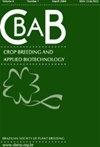与百香果种群的频率统计和贝叶斯统计相关联的Row-col方法
IF 1.1
4区 农林科学
Q3 AGRONOMY
引用次数: 0
摘要
本研究旨在检验在西番莲群体评价中加入行因子和列因子的频率模型和贝叶斯模型的显著性,并选择有潜力的基因型形成下一代。评估了以下参数:果数、产量、果重、果横径、果纵径、果肉百分比、果皮厚度和可溶性固形物总量。对于贝叶斯模型,考虑了两个先验,即逆伽马和带扩展参数的先验分布。与gamma逆模型相比,参数扩展的先验分布模型具有更低的均方根误差和更高的观测值与预测值的相关系数。此外,当选择强度为37%时,混合模型和贝叶斯模型在两个实验中选择的后代几乎相同。使用5倍交叉验证技术表明,两个测试模型都是有效的。本文章由计算机程序翻译,如有差异,请以英文原文为准。
Row-col method associated with frequentist and Bayesian statistics in a passion fruit population
This study was conducted to test the significance of adding row and column factors in the frequentist and Bayesian models used in the evaluation of a population of Passiflora edulis, as well as selecting promising genotypes to form the next generation. The following parameters were evaluated: number of fruits, yield, fruit weight, transverse fruit diameter, longitudinal fruit diameter, pulp percentage, skin thickness and total soluble solids. For the Bayesian model, two priors were considered, namely, inverse gamma and a priori distribution with extended parameters. The model with a priori distribution with extended parameters showed lower root mean square error and higher correlation coefficient between observed and predicted values than the inverse gamma model. Furthermore, for a selection intensity of 37%, the mixed and Bayesian models selected practically the same progenies in both experiments. The use of the 5-fold cross-validation technique indicated that both tested models were efficient.
求助全文
通过发布文献求助,成功后即可免费获取论文全文。
去求助
来源期刊

Crop Breeding and Applied Biotechnology
AGRONOMY-BIOTECHNOLOGY & APPLIED MICROBIOLOGY
CiteScore
2.70
自引率
13.30%
发文量
25
审稿时长
6-12 weeks
期刊介绍:
The CBAB – CROP BREEDING AND APPLIED BIOTECHNOLOGY (ISSN 1984-7033) – is the official quarterly journal of the Brazilian Society of Plant Breeding, abbreviated CROP BREED APPL BIOTECHNOL.
It publishes original scientific articles, which contribute to the scientific and technological development of plant breeding and agriculture. Articles should be to do with basic and applied research on improvement of perennial and annual plants, within the fields of genetics, conservation of germplasm, biotechnology, genomics, cytogenetics, experimental statistics, seeds, food quality, biotic and abiotic stress, and correlated areas. The article must be unpublished. Simultaneous submitting to another periodical is ruled out. Authors are held solely responsible for the opinions and ideas expressed, which do not necessarily reflect the view of the Editorial board. However, the Editorial board reserves the right to suggest or ask for any modifications required. The journal adopts the Ithenticate software for identification of plagiarism. Complete or partial reproduction of articles is permitted, provided the source is cited. All content of the journal, except where identified, is licensed under a Creative Commons attribution-type BY. All articles are published free of charge. This is an open access journal.
 求助内容:
求助内容: 应助结果提醒方式:
应助结果提醒方式:


